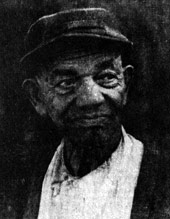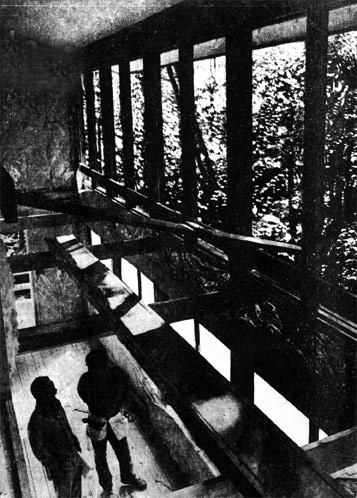|
Let the sun shine in . . .
Saw Miller And Scientist Collaborate
Durham Morning Hearld, by Jack Adams | Oct. 26, 1980
 | | Green Struck Up Deal with Young Duke Scientist |
The bright young scientist was riding his bicycle along Dixon Road, near Hope Valley, a few years ago when he spotted the wizened old saw miller sitting on his porch and rocking.
So the scientist stopped and chatted a while, and being a real estate dealer on the side, he worked up a couple of deals.
One of the deals is Green Mill, a name older than Durham, an idea in its infancy: a new development of passive solar houses.
The scientist-real estate man is Freeman Ledbet-ter, now 39, a research associate in pharmacology at Duke University.
The saw miller is Mar-cellus Green, now 90, whose family operated the Green Hill for longer than anybody can remember.
Ledbetter and Green share a passion: back to the basics, homegrown food, a clean environment. Science gives Ledbetter a grasp of why it needs to be done today. Experience gives Green assurance that his young friend is heading in the right direction.
 “I know something about the world,” says Green through a toothless smile, and you’re sure he does. “I know something about the world,” says Green through a toothless smile, and you’re sure he does.
“I can relate to the sen-sitivity of the human body,” says Ledbetter, whose research is on nerve cells. “I’m just hypersensitive to it.”
Thus, Ledbetter is de-veloping Green Mill as an environmentally clean, fossil-fuel-efficent project.
And Green is happily wandering around surveying the whole affair, re-membering the days when he and his daddy and brother timbered and farmed it. Green, who sold part of his land to Ledbetter, says he isn’t dis-appointed that his wilderness is being turned into a development.
Green Mill is one house up and one foundation poured along two cul de sacs off Dixon Road. If everything goes according to plan, there’ll be 36 pas-sive solar houses on the 31 acres right across the road from Green’s 40-year-old sagging frame house that is being shored up to last a little longer.
So what is a passive solar house?
You may find one in Wake County and one in Chapel Hill, but they’re not lined up like boxes in any of the subdivisions. Green Mill will the first subdivision fully using passive solar energy as the primary means of heating houses.
Passive means that the houses won’t have the par-aphanelia commonly associated with solar houses: the rooftop col-lectors, the water storage tanks and the tubing.
Instead, the houses planned for Green Mill will use an expanse of windows facing south to get maximum benefit of the sun for heating, solariums on the south side to store the heat and mostly non-mechanical convection principles to circulate the heat.
Louis Shook of Chapel Hill, a shipbuilding engineer who has designed and built houses for the last 30 years, full time for the past three years, is three-fourths the way through the first house in the development.
“I never have been pleased with conventional houses,” said Shook. “This is so simple (to build).”
Ledbetter and Shook estimate that energy savings in a passive solar house will be 60 percent or more. All of the houses will include wood stoves, Ledbetter said, as well as a conventional heating system, which is required by mortgage lenders. He said he hopes to see the day come when lenders will not require conventional heating systems.
Shook is building, on speculation, what is called an “envelope house.” He is using a variation of a design by Lee Porter Butler of San Francisco.
The idea is that the 300-square-foot solarium on the south side and a double wall on the north side, plus thick fiberglass insulation in the sides, floor and ceiling, will serve as an envelope around the living quarters.
The envelope will serve several functions: collecting warm air on the south, additional insulation and natural convection based on the fact that hot air rises.
The solarium will double as a greenhouse. Although 10 feet wide by 30 feet long, accounting for one-sixth of the 1,800 square feet in the house (1,500 for living quart-ers), Ledbetter says the solarium could be small by other standards in the development.
The second house under way will have a 600-foot solarium, the size Ledbetter says he wants for the house he will build for himself in Green Mill. You can grow vegetables year-around, organically, without fear of insects, he says.
Shook said the envelope-type construction is no more expensive than conventional building. He is asking $92,500 for the house he is building and believes he’ll sell it more quickly than he could a similarly priced conventional house.
Ledbetter said that price will be on the low end in the development. He is projecting houses up to 2,600 square feet.
The Green property once totaled about 200 acres. The 31-acre Green Mill development includes on it a small cemetery on which are buried the Greens and the people who previously owned the property, the Pearsons.
According to research done by Freeman Ledbet-ter’s brother Clarence Ledbetter, a lawyer, the cemetery includes the tombstones of Mr. and Mrs. William Pearson, parents of Sarah Pearson Angier Duke, for whom the gardens at Duke University are named.
Green says he was entrusted with the care of the cemetery by Mrs. Duke, whom he knew as “Miss Sally.”
The graves of William Pearson (1788-1862) and Pearson family members are enclosed by a wrought-irpn fence, still in fair condition. Freeman Ledbetter said he plans to do some restoration and to keep it up as part of the tradition of the develop-ment.
Green still walks across Dixon Road now and then to keep tabs on the cemetery. But he’s also busy with his plans for the future.
He says he’s going to set up the saw mill again (it’s been shut down since 1973) so people in the neighborhood can come by and cut their own wood.
|